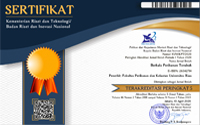The Effect of Seaweed (Eucheuma spinosum) Fortification on The Quality of Pekdos
Abstract
This study aims to determine the effect of fortification of seaweed (Eucheuma spinosum)
on the quality of pekdos and determine the amount of seaweed addition to producing the
best quality of pekdos. The research method used was experimental with the processing
of pekdos with the addition of seaweed porridge (E. spinosum) in different
concentrations. The research design was a completely randomized design (CRD)
consisting of 4 treatment levels, P0 (0%), P1 (5%), P2 (10%), and P3 (15%). Parameter
analysis of organoleptic, moisture content, ash, protein, fat, and crude fiber. The results
showed that seaweed fortification had a significant effect on the 95% confidence level
on the quality of pekdos. The addition of 10% (P2) seaweed produced the best quality
pekdos. The pekdos has a neat appearance intact, slightly hollow, attractive, and slightly
yellowish-white; the aroma is not fishy, fresh, fragrant, and specific type of pekdos
mackerel; tasted specific type of pekdos taste, savory, and very tasty; and a chewy soft,
and easy-to-bite texture; pekdos has 37.40% moisture; 3.54% ash; 14.92% protein;
4.41% fat, and 4.39% crude fiber.
Keywords
Full Text:
PDFReferences
[AOAC] Association of Official Analytical Chemist. (2012). Official Methods of Analysis 18th
Edition. Gaitherburg, AOAC International.
[Dispar Karimun] Dinas Pariwisata dan Kebudayaan Kabupaten Karimun. (2020). Pokok Pikiran
Kebudayaan Daerah 2020 Kabupaten Karimun Provinsi Riau. In Dinas Pariwisata dan
Kebudayaan Kabupaten Karimun. Kepulauan Riau
[DKP Kepri] Dinas Kelautan dan Perikanan Provinsi Kepulauan Riau. (2020). Laporan Kinerja
Instansi Pemerintah (LKjIP) Tahun 2019. Kepulauan Riau.
[SNI] Standar Nasional Indonesia 7661.1:2013. (2013). Pempek Ikan Rebus Beku – Bagiain 1:
Spesifikasi. Jakarta: Badan Standarisasi Nasional.
Amaliah, S., M, A., & Sakinah, H. (2016). Pengaruh Penambahan Bubur Rumput Laut (Kappaphycus
alvarezii) terhadap Karakteristik Bakso Ikan Payus (Elops hawaiensis). Jurnal Perikanan Dan
Kelautan., 6(1), 40–50.
Azlan. (2019). Alur Proses Produksi Kolagen Rumput Laut Tahap 1 dan 2. Moro Kabupaten Karimun
Kepulauan Riau: CV. Moro’s Pure Marine Collagen.
Brownlee, I. A., Allen, A., Pearson, J. P., Dettmar, P. W., Havler, M. E., Atherton, M. R., & Onsoyen,
E. (2005). Alginate as a Source of Dietary Fiber. Crit. Rev. Food Sci. Nutr., 45, 497–510.
Dawczynski, C., Schubert, R., & Jahreis, G. (2007). Amino Acids, Fatty Acids, and Dietary Fibre in
Edible Seaweed Products. J. Food Chem., 103, 891–899.
Dharmananda, S. (2002). The nutritional and medicinal value of seaweeds used in Chinese medicine,
Available:
Dwiyitno. (2011). Rumput Laut sebagai Sumber Serat Pangan Potensial. Squalen, 6(1), 9–17.
Fardiaz, S. (1989). Hidrokoloid. Laboratorium kimia dan biokimia pangan. PAU Pangan dan Gizi,
Institut Pertanian Bogor. Bogor.
Fellows, P. J. (2000). Food Processing Principle and Practise. Ellies Horwood Limited, New York.
Fleury, N., & Lahaye, M. (1991). Chemical and physicochemical characterization of fibers from
Laminaria digitata (Kombu Breton)—A physiological approach. J Sci Food Acgric, 55, 389–400.
Hasanah, R. (2007). Pemanfaatan Rumput Laut (Glacilaria sp.) dalam Peningkatan Kandungan Serat
Pangan Pada Sponge Cake. [Skripsi]. Teknologi Hasil Perikanan. Fakultas Perikanan dan Ilmu
Kelautan. Institut Pertanian Bogor. Bogor.
Holdt, S. L., & Kraan, S. (2011). Bioactive Compounds in Seaweed: Functional Food Applications and
Legislation. J. Appl. Phycol, 23, 543–597.
Hustiany, R. (2016). Reaksi Maillard Pembentuk Citarasa Dan Warna Pada Produk Pangan.
Banjarmasin: Lambung Mangkurat University Press.
Jayasinghe, P. S., Pahalawattaarachchi, V., Ranaweera, K. K. D. S., & Author, C. (2016). Seaweed
Extract As a Natural Food Coloring Agent in Jelly Desserts on Chemical, Microbial and Sensory
Quality.
Academy
of
Agriculture
Journal,
(March),
–69.
http://innovativejournal.in/aaj/index.php/aaj
Lahaye, M. (1991). Marine-algae as Sources of Fibers-determination of Soluble and Insoluble Dietary
Fiber Contents in Some Sea Vegetables. J. Sci. Pertanian Makanan, 54, 587–594.
Lee,
R.
E.
(2008).
Phycology. Cambridge University
Press.
https://doi.org/10.1017/CBO9780511812897
Mabeau, S., & Fleurence, J. (1993). Seaweed in food products: biochemical and nutritional aspects. In
Trends in Food Science and Technology (Vol. 4, Issue 4, pp. 103–107). Elsevier.
https://doi.org/10.1016/0924-2244(93)90091-N
Maslin, S., Sri, W., & Ansharullah. (2017). Pengaruh Penambahan Rumput Laut (Eucheuma Cottonii)
terhadap Penilaian Organoleptik Mie Wikau Maombo. J. Sains Dan Teknologi Pangan, 2(5),
–888.
Mendis, E., & Kim, S.-K. (2011). Present and future prospects of seaweeds in developing functional
foods. Advances in Food and Nutrition Research, 64, 1–15. https://doi.org/10.1016/B978-0-12387669-0.00001-6
Merdekawati,
W.,
&
Susanto,
A.
B. (2009). Kandungan Dan Komposisi Pigmen Rumput Laut Serta
Potensinya Untuk Kesehatan. Squalen Bulletin of Marine and Fisheries Postharvest and
Biotechnology, 4(2), 41. https://doi.org/10.15578/squalen.v4i2.147
Murata, M., & Nakazoe, J. (2001). Production and Use of Marine Algae in Japan. Jpn. Agric. Res. Q,
, 281–290.
Parimala, K. R., & Sudha, M. L. (2012). Effect of hydrocolloids on the rheological, microscopic, mass
transfer characteristics during frying and quality characteristics of puri. Food Hydrocolloids,
(1), 191–200. https://doi.org/10.1016/j.foodhyd.2011.07.005
Puspitasari, E. (2009). Karamelisasi Gula. Jakarta: Ghalia Indonesia.
Rajapakse, N., & Kim, S. K. (2011). Nutritional and Digestive Health Benefits of Seaweed. Advances
in Food and Nutrition Research, 64, 17–28.
Ścieszka, S., & Klewicka, E. (2018). Algae in Food - A General Review. Critical Reviews in Food
Science and Nutrition, 59(21), 3538–3547. https://doi.org/10.1080/10408398.2018.1496319
Suryaningrum, T. D., Murdinah, & Arifin, M. (2002). Penggunaan Kappa-karaginan Sebagai Bahan
Penstabil pada Pembuatan Fish Meat Loaf dari Ikan Tongkol (Euthynnus affinis. L). Jurnal
Penelitian Perikanan Lndonesia, 8(6), 33–43.
Suwandi, R. I., Setyaningsih, R. B., & Uju, S. (2002). Rekayasa Proses Pengolahan dan Optimasi
Produksi Hidrokoloid Semi Basah (Intermediate Moisture Food) dari Rumput Laut. [Laporan
Akhir Penelitian Hibah Bersaing Perguruan Tinggi Tahun Anggaran 2001/2002]. Fakultas
Perikanan dan Ilmu Kelautan, Institut Pertanian Bogor, Bogor.
Venugopal, S. (2010). Food and Nutrition Departement, Faculty of family and Community.
Widodo, S. A. (2008). Karakteristik Sosis Ikan Kurisi (Nemipterus nematophorus) dengan
Penambahan Isolat Protein Kedelai dan Karagenan pada Penyimpanan Suhu Chilling dan
Freezing. [Skripsi] Fakultas Perikanan dan Ilmu Kelautan. Institut Pertanian Bogor.
Winarno, F. G. (1996). Teknologi Pengolahan Rumput Laut. Jakarta: Pusat Sinar Harapan.
Winarno, F. G. (2008). Kimia Pangan dan Gizi. Bogor: M. Brio Press.
Zuhra, C. F. (2006). Flavor (Cita Rasa). Departemen Kimia Fakultas Matematika dan Ilmu
Pengetahuan Alam, Universitas Sumatera Utara: USU Repository.
DOI: http://dx.doi.org/10.31258/terubuk.49.2.1033-1041
Refbacks
- There are currently no refbacks.
Copyright (c) 2021 Marwah Iwada, Sumarto Sumarto, Dewita Dewita

This work is licensed under a Creative Commons Attribution 4.0 International License.












